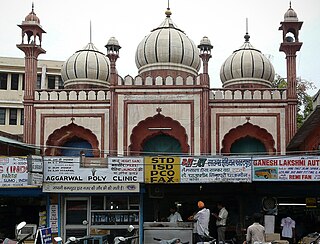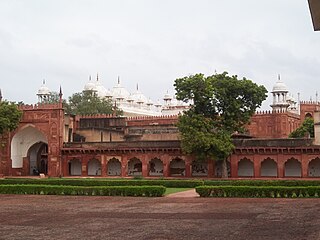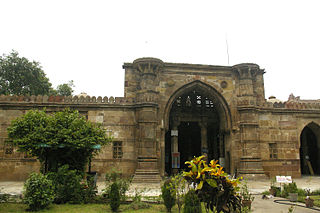
The Lahore Fort is a citadel in the walled interior of Lahore in Punjab, Pakistan. The fortress is located at the northern end of the Walled City and spreads over an area greater than 20 hectares. It contains 21 notable monuments, some of which date to the era of Emperor Akbar. The Lahore Fort is notable for having been almost entirely rebuilt in the 17th century, when the Mughal Empire was at the height of its splendor and opulence.

The Masjid-i-Jehan-Numa, commonly known as the Jama Masjid of Delhi, is one of the largest Sunni mosques in India.

Mughal architecture is the type of Indo-Islamic architecture developed by the Mughals in the 16th, 17th and 18th centuries throughout the ever-changing extent of their empire in the Indian subcontinent. It developed from the architectural styles of earlier Muslim dynasties in India and from Iranian and Central Asian architectural traditions, particularly Timurid architecture. It also further incorporated and syncretized influences from wider Indian architecture, especially during the reign of Akbar. Mughal buildings have a uniform pattern of structure and character, including large bulbous domes, slender minarets at the corners, massive halls, large vaulted gateways, and delicate ornamentation; examples of the style can be found in modern-day Afghanistan, Bangladesh, India and Pakistan.

The Moti Masjid is a 17th-century historical mosque, not open for worship, inside the Red Fort complex in North Delhi, India. It was built by Mughal emperor Aurangzeb, damaged during the Siege of Delhi, and subsequently restored by the British. Named for its white marble, the mosque features ornate floral carvings. It is an important example of Mughal architecture during Aurangzeb's reign.

The Jamia Masjid is a Friday mosque, located at Nowhatta in the Old City of Srinagar, in the union territory of Jammu and Kashmir, India. The mosque was commissioned by Sultan Sikandar in 1394 CE and completed in 1402 CE, at the behest of Mir Mohammad Hamadani, son of Mir Sayyid Ali Hamadani, and is regarded as one of the most important mosques in Kashmir. The mosque is located in a central zone in the religio-political life in Srinagar. Thronged by Muslims every Friday, it is a prime tourist attraction of the city.

The Taj-ul-Masajid, also known as the Tāj-ul-Masjid, is a Sunni mosque, affiliated with Tablighi Jamaat, part of the Deobandi movement, located in Bhopal, in the state of Madhya Pradesh, India. With capacity for c. 175,000 worshippers, it is the largest mosque in India and, as of 2014, was the ninth largest mosque in the world.

The Lal Masjid of Delhi, also known as the Fakr-ul Masjid or Sikandar Sahib's Masjid, is a mosque located in Bara Bazaar, near the Kashmiri Gate in Old Delhi, in the north of the city, in India.

Moti Masjid, one of the "Pearl Mosques", is a 17th-century religious building located inside the Lahore Fort, Lahore, Punjab, Pakistan. It is a small, white marble structure built by Mughal emperor Jahangir and modified by the architects of Shah Jahan, and is among his prominent extensions to the Lahore Fort Complex. The mosque is located on the western side of Lahore Fort, closer to Alamgiri Gate, the main entrance.
Moti Masjid, may refer to:

The Moti Masjid is a 17th-century congregational mosque located within the Agra Fort UNESCO World Heritage Site. Built by Mughal Emperor Shah Jahan, the mosque is made entirely of white marble.

Moth ki Mosque is a 16th-century mosque located in the South Delhi district of India. The mosque was built in 1505 by Wazir Miya Bhoiya, Prime Minister during the reign of Sikander Lodi of the Lodi dynasty. It was a new type of mosque developed by the Lodis in the fourth city of the medieval Delhi Sultanate. This mosque was considered a beautiful domed (gumbad) structure of the period.

The Jama Masjid, also known as Jumah Mosque or Jami' Masjid, is a Friday mosque, located in Ahmedabad, in the state of Gujarat, India. It was built in 1424 during the reign of Ahmad Shah I. The inscription on the central mihrab commemorates the inauguration of the mosque in AH 827 (1423/1424 CE), on the 1st Sarar, or January 4, by Sultan Ahmad Shah I. The mosque lies in the old walled city, and it is situated outside Bhadra Fort area. The old walled city is divided into separate quarters or pols, and the Jami' Masjid is found on the Gandhi Road. Along the south side of the road, the mosque is a short distance beyond the Teen Darwaza or Tripolia Gate. The structure is a Monument of National Importance.

The Ahmad Shah's Mosque, also known as Shahi Jam-e-Masjid or Juni Juma Masjid, completed in 1414, is the oldest mosque of Ahmedabad, in the state of Gujarat, India. The structure is a Monument of National Importance.

Baba Lului's Mosque, also known as Baba Lavlavie's Masjid, is a Sufi mosque and dargah complex in Behrampura area of Ahmedabad, India. The structure is a Monument of National Importance.

The Jama Mosque, or Jama Masjid, is a Sunni Islam mosque, located in Bhilai, Chhattisgarh, India. The mosque was completed in the 1960s and can accommodate 3,000 worshippers at a time and is one of the largest mosques in the state, and also in Asia. It is the first mosque in the world to be built in the shape of the word "Ya Allah" in Arabic script. It took three years for the construction of the mosque which was completed in 1967.

Makrana marble is a type of white marble, popular for use in sculpture and building decor. It is mined in the town of Makrana in Rajasthan, India, and was used in the construction of several iconic monuments such as the Taj Mahal in Agra and Masjid-e-Rasheed in Deoband and the Victoria Memorial in Kolkata. The Makrana Marble is listed as a GHSR by International Union of Geological Sciences

The Lat Mosque is a mosque in Dhar in the state of Madhya Pradesh, India. Named after the Iron pillar of Dhar, it is also known as Lat ki masjid, Ladh Masjid, or Lath Masjid.

The Jama Masjid, also called Jami Masjid, is an historic Friday mosque in Mandu in the Dhar district of the state of Madhya Pradesh, India. Built in Mughal style, the mosque has been believed to have been built during the reign of Hoshang Shah and completed during the reign of Mahmud Khilji in 1454 CE.

The Moti Masjid is an 18th-century Mughal mosque located in Mehrauli, in the South Delhi district of India. Named for its white marble, the mosque was constructed during the reign of Bahadur Shah I, in the vicinity of the dargah of Qutbuddin Bakhtiar Kaki.

The Zeenat-ul-Masajid, also written as Zeenat-ul-Masjid and popularly known as the Ghata Masjid, is an 18th-century Mughal mosque located in Daryaganj, Central Delhi, India. The mosque was commissioned by Zeenat-un-Nissa, the second daughter of the Mughal emperor Aurangzeb.























